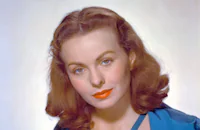The film introduces us to Mr. and Mrs. Phillips and their two children, a nice family in a nice car moving to a nice motel they bought in the nice California desert. Why? Well, Papa Phillips damaged his back in a car wreck and now needs to live in a warm, sunny environment. However they cross paths with hellion Gloria and her two decidedly not nice boyfriends who have nothing better to do than make life rough for the Phillips family. Arriving at their recently purchased motel, the Phillips discover that instead of having solved their problems, things only get worse.
The source of Hot Rods To Hell was a 1956 Saturday Evening Post story. It was originally conceived as a TV movie but Hot Rods to Hell turned out to be too rough for that era's television so instead it went out to drive-in theatres across the country. John Brahm, a respected studio director of the forties (The Lodger, 1944), helmed this youth flick, though at this time he was better known for his television work. And as a concession to the older generation, the Phillips family was ingeniously cast with familiar faces from Hollywood's past: Dana Andrews of While the City Sleeps (1956) and Daisy Kenyon (1947) as well as Jeanne Crain of Cheaper By the Dozen (1950). These two had earlier co-starred in three films together, most notably 1945's State Fair.
The other actors weren't as well-known at the time. Gloria was played by Mimsy Farmer, perhaps the definition of a cult actress. After a few other B-movies like 1966's Riot on Sunset Strip (which has three other Hot Rods actors), Farmer headed for Europe where she appeared in Dario Argento's Four Flies on Grey Velvet (1971), the Taviani Brothers' Allonsanfan (1973) and Marco Ferreri's Bye Bye Monkey (1977). In one scene of Hot Rods to Hell are background performances by Mickey Rooney Jr.'s group, described by musician Marshall Crenshaw as a "sort of poor man's Bobby Fuller Four." (Rumor has it that somewhere in the bar scene you can spot Liz Renay, a sometimes soap actress who went on to Blackenstein (1973) and John Waters' Desperate Living, 1977)
Hot Rods to Hell was the work of genius exploitation producer Sam Katzman, who had worked on b-movies and serials since the mid-30s. He hit an unsuspected goldmine with the youth market of the 1950s, producing dozens of titles like Earth vs. the Flying Saucers (1956), Don't Knock the Rock (1956), Twist Around the Clock (1961), Get Yourself a College Girl (1964) and other prime fodder for youth after thrills, chills and excitement. One film historian claims that no Katzman film ever lost money, completely plausible considering their low cost and built-in audiences. But it certainly helped that Katzman delivered the promised goods since, as Hot Rods to Hell shows, these films weren't shoddy, tossed-together gyps but instead were quite entertaining on their own terms.
Producer: Sam Katzman
Director: John Brahm, James Curtis Havens
Screenplay: Alex Gaby (story), Robert E. Kent
Cinematography: Lloyd Ahern
Film Editing: Ben Lewis
Original Music: Fred Karger, Ben Weisman (songs)
Cast: Dana Andrews (Tom Phillips), Jeanne Crain (Peg Phillips), Mimsy Farmer (Gloria), Laurie Mock (Tina Phillips), Paul Bertoya (Duke), Gene Kirkwood (Ernie).
C-100m.
by Lang Thompson





















